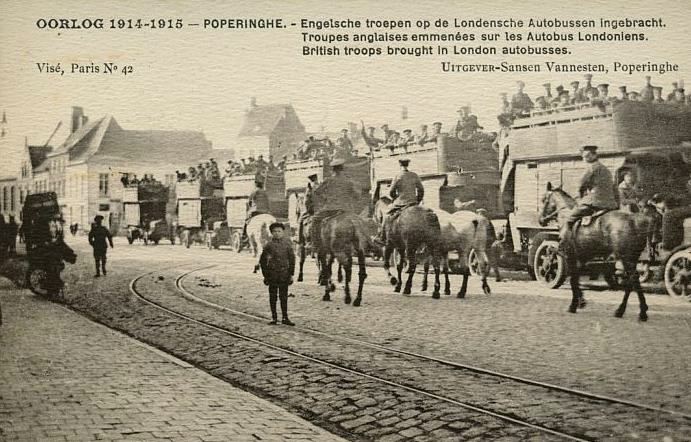|
Poperinge, Belgium
Poperinge (; french: Poperinghe, ; vls, Poperienge) is a city and municipality located in the Belgian province of West Flanders, Flemish Region, and has a history going back to medieval times. The municipality comprises the town of Poperinge proper and surrounding villages. The area is famous for its hops and lace. The town Poperinge is situated about 13 km (8 miles) to the west of Ypres (Ieper). The region is famous for growing hops and furnishes 80% of Belgian production. The town is home to the national hop museum and is called "hops city", ''hoppe stad'' in Dutch, a play on ''hoofd stad'', the word for capital. A triennial hop festival and parade is held in the month of September. The local brew is known as Hommel (which means hops in the West Flanders dialect). The carillon in the tower of the town's oldest church, Sint-Bertinuskerk, was noted as one of the most beautiful in Flanders in mediaeval times. It was destroyed during wartime in 1677 and restored in 1781. Poperin ... [...More Info...] [...Related Items...] OR: [Wikipedia] [Google] [Baidu] |
Arrondissement Of Ypres
The Arrondissement of Ypres ( nl, Arrondissement Ieper; french: Arrondissement d'Ypres) is one of the eight administrative arrondissements in the Province of West Flanders, Belgium Belgium, ; french: Belgique ; german: Belgien officially the Kingdom of Belgium, is a country in Northwestern Europe. The country is bordered by the Netherlands to the north, Germany to the east, Luxembourg to the southeast, France to .... It is both an administrative and a judicial arrondissement. However, the Judicial Arrondissement of Ypres also comprises the municipalities of Staden and Moorslede in the Arrondissement of Roeselare. Municipalities The Administrative Arrondissement of Ypres consists of the following municipalities: * Heuvelland * Langemark-Poelkapelle * Mesen * Poperinge * Vleteren * Wervik * Ypres * Zonnebeke Ypres {{WestFlanders-geo-stub ... [...More Info...] [...Related Items...] OR: [Wikipedia] [Google] [Baidu] |
Kent
Kent is a county in South East England and one of the home counties. It borders Greater London to the north-west, Surrey to the west and East Sussex to the south-west, and Essex to the north across the estuary of the River Thames; it faces the French department of Pas-de-Calais across the Strait of Dover. The county town is Maidstone. It is the fifth most populous county in England, the most populous non-Metropolitan county and the most populous of the home counties. Kent was one of the first British territories to be settled by Germanic tribes, most notably the Jutes, following the withdrawal of the Romans. Canterbury Cathedral in Kent, the oldest cathedral in England, has been the seat of the Archbishops of Canterbury since the conversion of England to Christianity that began in the 6th century with Saint Augustine. Rochester Cathedral in Medway is England's second-oldest cathedral. Located between London and the Strait of Dover, which separates England from mainla ... [...More Info...] [...Related Items...] OR: [Wikipedia] [Google] [Baidu] |
Roesbrugge
Roesbrugge is a small rural village in the Belgian province of West Flanders. Roesbrugge is the larger of two villages that make up the "deelgemeente" Roesbrugge-Haringe in the municipality of Poperinge. Roesbrugge is located in the northwestern part of Poperinge and in the northern part of Roesbrugge-Haringe. The town center is located along the Yser river. An old branch of this river, the Dode IJzer (''Dead Yser'') makes up the northern border of the town center. The built-up area extends across the Dode IJzer into the hamlet Beveren-Kalsijde, a settlement on the territory of Beveren-aan-de-IJzer in the municipality of Alveringem. The small village of Haringe is located one kilometer to the southwest of Roesbrugge; both make up the deelgemeente Roesbrugge-Haringe. The Catholic church and parish of Roesbrugge are named after Saint Martin Saint Martin may refer to: People * Saint Martin of Tours (c. 316–397), Bishop of Tours, France * Saint Martin of Braga (c. 520 ... [...More Info...] [...Related Items...] OR: [Wikipedia] [Google] [Baidu] |
Abele (village)
Abele (also spelled Abeele) is a small village or hamlet in the city of Poperinge, in the Belgian province of West Flanders. The village is located on the territory of Poperinge proper and its "deelgemeente" Watou, but is also partly located on French territory. Abele has about 600 inhabitants, of whom about 100 are French. The main street coincides with the border between Belgium and France, so houses located on different sides of the street are located in a different country. The church of Abele is located on French territory, but the services are organized by the Roman Catholic Diocese of Bruges. The of Watou and the local authorities of Boeschepe are responsible for its maintenance. Abele used to be an import border crossing. In 1713, a tollhouse was set up, but it disappeared during the French Revolution The French Revolution ( ) was a period of radical political and societal change in France that began with the Estates General of 1789 and ended with ... [...More Info...] [...Related Items...] OR: [Wikipedia] [Google] [Baidu] |
Roesbrugge-Haringe
Roesbrugge-Haringe is a place in the Belgian province of West Flanders. It is a part of the municipality (a deelgemeente) of Poperinge. Roesbrugge-Haringe consists of two small rural villages, Roesbrugge and Haringe, located in the north western region of Poperinge. Roesbrugge, the largest of both villages, is located along the Yser river. Haringe is located one kilometer to the south west of Roesbrugge, close to the French French (french: français(e), link=no) may refer to: * Something of, from, or related to France ** French language, which originated in France, and its various dialects and accents ** French people, a nation and ethnic group identified with Franc ... border. Poperinge Populated places in West Flanders {{WestFlanders-geo-stub ... [...More Info...] [...Related Items...] OR: [Wikipedia] [Google] [Baidu] |
Reningelst
Reningelst is a rural village in the Belgian province of West Flanders, and a "deelgemeente" of the municipality Poperinge. The village has about 1405 inhabitants. The deelgemeente of De Klijte used to be a part of Reningelst (then independent, now part of Heuvelland). De Klijte split from Reningelst in 1976 and is now part of the Heuvelland municipality. Sports Reningelst is host to several major cycling races each year. Reningelst calls itself a wielerdorp. Every year during the kermisweek a number of major cycling races happen here. The Eight of Reningelst owes its name to an 8-shaped trail in and around the village. Sightseeing and cultural life Probably the most popular tourist site is the Catholic village church, the St. Vedastuskerk. In the year 1568 three priests of Reningelst were murdered here because of the religious persecution during that period. The church was burned down in 1623 by Ypres Geuzen and was rebuilt to it current, Gothic architecture circa 162 ... [...More Info...] [...Related Items...] OR: [Wikipedia] [Google] [Baidu] |
Proven
Proven is a rural village in the Belgian province of West Flanders, and a "deelgemeente" of the municipality Poperinge. The village has about 1400 inhabitants. The church and parish of Proven are named after Saint Victor. The Saint Victor Church was rebuilt in 1806, after the late Gothic International Gothic is a period of Gothic art which began in Burgundy, France, and northern Italy in the late 14th and early 15th century. It then spread very widely across Western Europe, hence the name for the period, which was introduced by t ... church from the early 17th century burnt down in 1802. In popular speech, the tower is called "peperbus" ( pepper shaker). Poperinge Populated places in West Flanders {{WestFlanders-geo-stub ... [...More Info...] [...Related Items...] OR: [Wikipedia] [Google] [Baidu] |
Deelgemeente
A deelgemeente (, literally ''part-municipality'') or section (French) is a subdivision of a municipality in Belgium and, until March 2014, in the Netherlands as well. Belgium Each municipality in Belgium that existed as a separate entity on 1 January 1961 but no longer existed as such after 1 January 1977 as the result of a merger is considered a ''section'' or ''deelgemeente'' within most municipalities. In addition, the City of Brussels is also divided in four ''sections'' that correspond to the communes that existed before their merger in 1921. The term ''deelgemeente'' is used in Dutch and the term ''section'' in French to refer to such a subdivision of a municipality anywhere in Belgium, municipalities having been merged throughout the country in the 1970s. Herefor, ''sections'' or ''deelgemeenten'' usually were independent municipalities before the fusions in the 1970s. In French, the term ''section'' is sometimes confused with ''commune'' (for: municipality), especially ... [...More Info...] [...Related Items...] OR: [Wikipedia] [Google] [Baidu] |
Dirk D
A dirk is a long bladed thrusting dagger.Chisholm, Hugh (ed.), ''Dagger'', The Encyclopædia Britannica, 11th ed., Vol. VII, New York, NY: Cambridge University Press (1910), p. 729 Historically, it gained its name from the Highland Dirk (Scots Gaelic "Dearg") where it was a personal weapon of officers engaged in naval hand-to-hand combat during the Age of SailO'Brian, Patrick, ''Men-of-War: Life In Nelson's Navy'', New York: W.W. Norton & Co., (1974), p. 35 as well as the personal sidearm of Highlanders. It was also the traditional sidearm of the Highland Clansman and later used by the officers, pipers, and drummers of Scottish Highland regiments around 1725 to 1800 and by Japanese naval officers. Etymology The term is associated with Scotland in the Early Modern Era, being attested from about 1600. The term was spelled ''dork'' or ''dirk'' during the 17th century,Head, T.F. ''The Concise Oxford Dictionary of English Etymology'' Oxford University Press (1996) presumed relate ... [...More Info...] [...Related Items...] OR: [Wikipedia] [Google] [Baidu] |
Walloon Brabant
Walloon Brabant (french: Brabant wallon ; nl, Waals-Brabant ; wa, Roman Payis) is a province located in Belgium's French-speaking region of Wallonia. It borders on (clockwise from the North) the province of Flemish Brabant (Flemish Region) and the provinces of Liège, Namur and Hainaut. Walloon Brabant's capital- and largest city is Wavre. The provincial population was recorded at 403,599 as of January 2019, giving a population density of . Etymology Walloon is a Belgian version of a old West Germanic word reconstructed as *walh (“foreigner, stranger, speaker of Celtic or Latin”). Brabant is from Old Dutch *brākbant (attested in Medieval Latin as pāgus brācbatensis, Bracbantum, Bracbantia), from Frankish, a compound of Proto-Germanic *brēk-, *brekaną (“fallow, originally 'to break'”) + *bant-, *bantō, *banti (“district, region”) Like the terms "Belgium" and "Flanders", the terms "Walloon" and "Brabant" are much older than the modern political entities whi ... [...More Info...] [...Related Items...] OR: [Wikipedia] [Google] [Baidu] |



